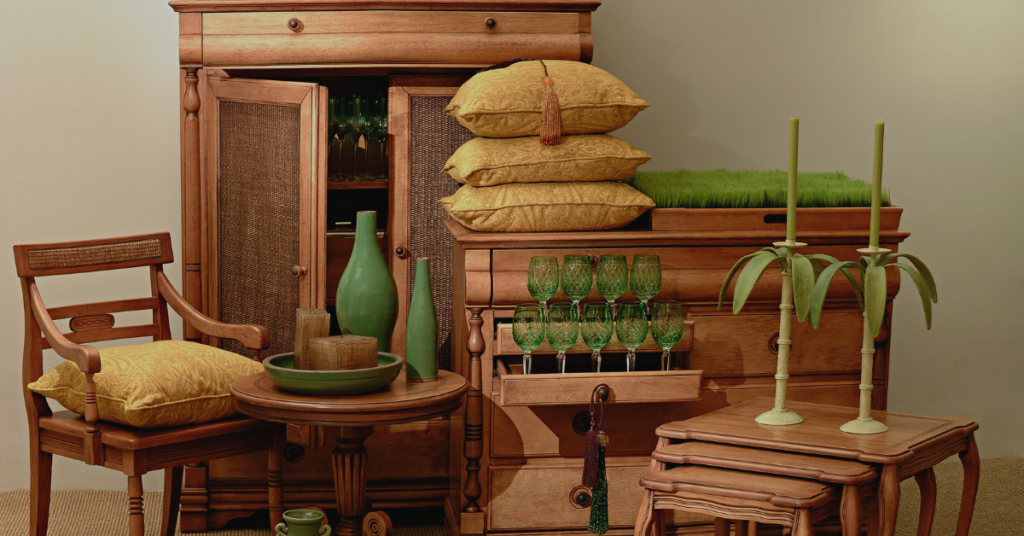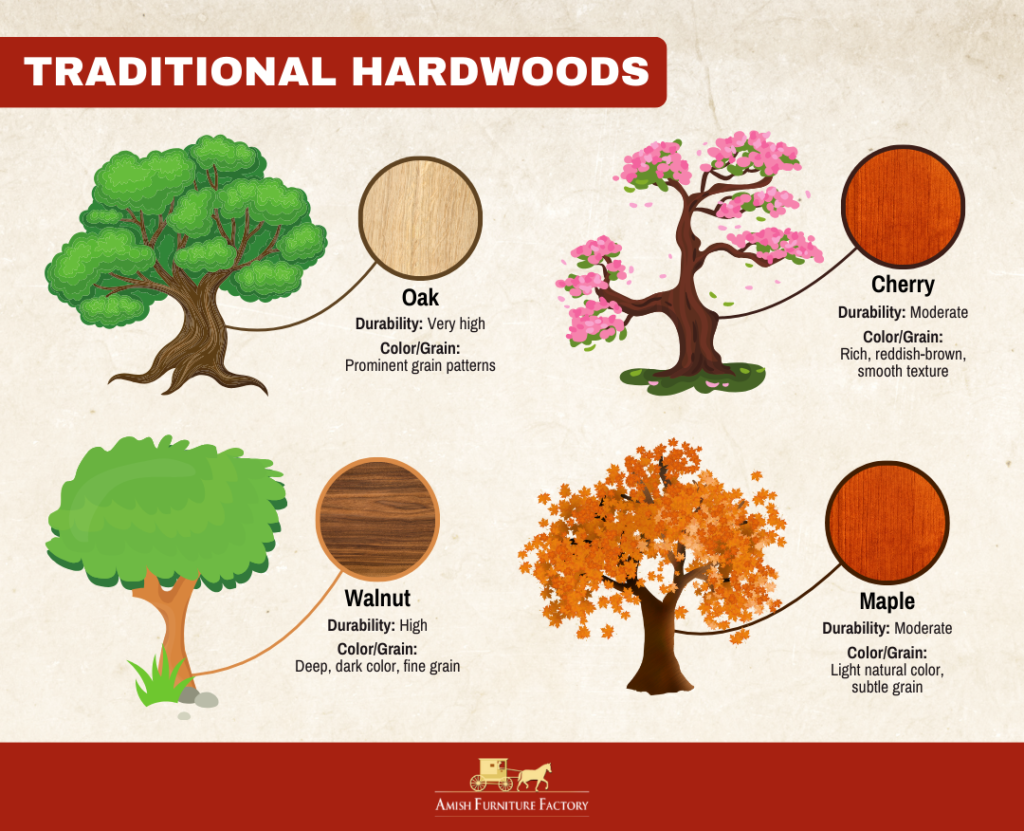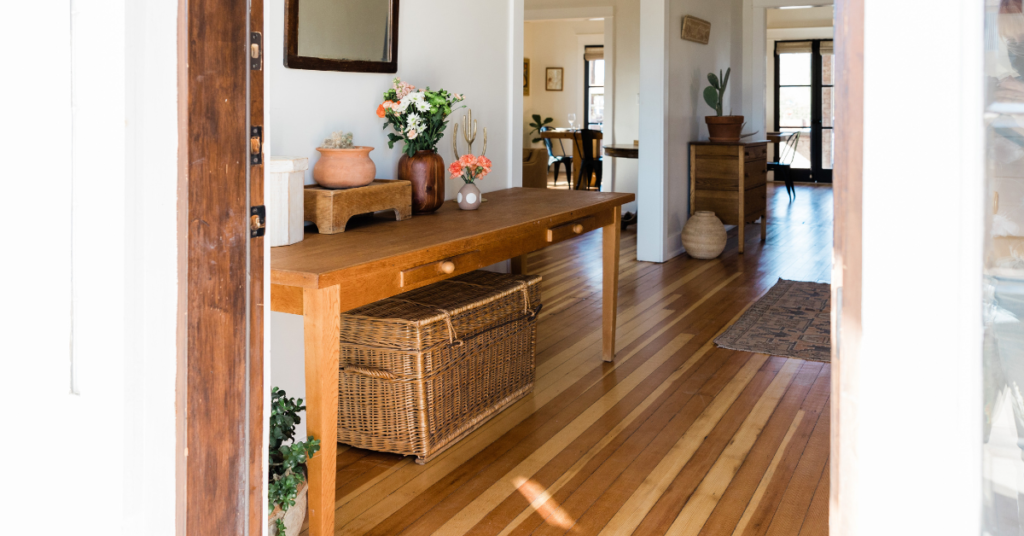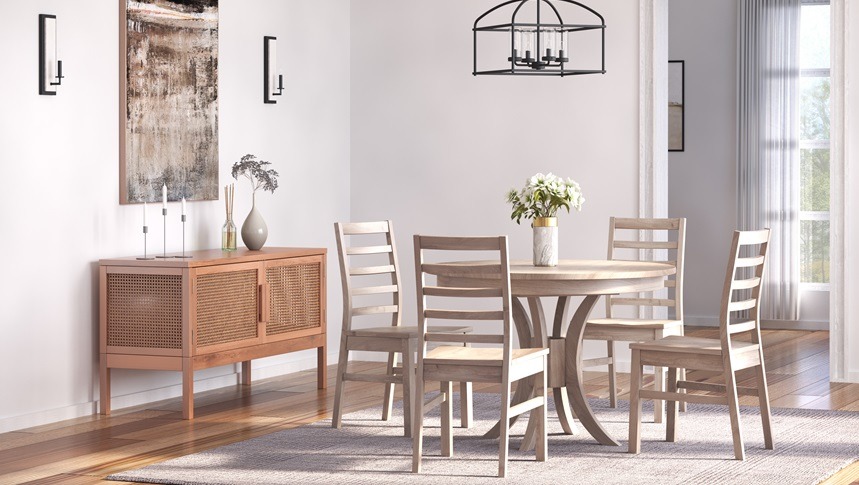
Furniture trends for 2025 are evolving dramatically, with Amish furniture leading the way in blending traditional craftsmanship with modern design elements. These trends are not just about aesthetics but also embrace sustainability, innovative materials, and adaptive styles for contemporary living.
Key Takeaways
- In 2025, the emphasis is on minimalist Amish furniture that combines streamlined shapes with a focus on function and style, perfectly balancing aesthetics and practicality.
- Rustic and farmhouse styles remain a cornerstone of Amish furniture offerings, cherished for warmth and inviting nature.
- Sustainability, health, and heritage woods are at the forefront of material trends.
- The color and texture trends in Amish furniture for 2025 are all about creating a natural and tactile experience.
- Amish furniture makers are embracing new tools and platforms to enhance their craft and reach wider audiences.
Curious about how these trends can transform your home? This article explores the most notable trends in Amish furniture for 2025, giving your home a fresh and modern feel while staying true to timeless craftsmanship.
Trending Amish Furniture Styles for 2025
When it comes to furniture, the Amish home builders have long been admired for their craftsmanship and timeless designs. In 2025, the Amish furniture scene continues to evolve, blending traditional techniques with modern sensibilities.
Modern Amish Furniture Designs

The Amish furniture industry is transforming significantly by adopting modern design principles. This year, the emphasis is on sleek, functional styles that blend well with today’s minimalist interior design trends.
Traditionally known for their exceptional craftsmanship, the Amish now use their skills to create furniture with a contemporary look. These simple modern pieces feature clean lines and minimal detailing, making them versatile for various interiors.
Amish furniture makers are innovating without compromising their commitment to quality and durability. Their shift towards modern styles enhances the traditional appeal of their craftsmanship, attracting a wider audience. Popular items now include sleek hardwood coffee tables and elegant, simple dining sets that offer beauty and long-lasting use.
Rustic and Farmhouse Styles in Amish Furniture
Rustic and farmhouse styles remain essential in Amish pieces, valued for their warmth and welcoming feel. These styles showcase a deep appreciation for natural wood and traditional craftsmanship.
In 2025 Amish artisans skillfully combine classic features with modern needs, crafting furniture that fits well in contemporary homes while evoking a sense of nostalgia. For example, a handcrafted oak buffet can become a stunning focal point in a modern farmhouse kitchen, providing functionality and visual appeal.
The lasting popularity of rustic and farmhouse designs highlights a widespread desire for simplicity and comfort in our homes. Furniture in these styles is often viewed as more than just functional items; they are integral to the home’s character.
Minimalist Amish Pieces
The global shift towards minimalism is reshaping the Amish furniture industry. Simplified designs that focus on practicality and comfort are gaining momentum.
According to Josh Qian, the COO and Co-Founder of Best Online Cabinets:
“I’ve closely observed the interplay between craftsmanship and evolving design trends, especially in Amish furniture. The minimalist trend is undoubtedly shaping the future of this sector, and I anticipate a fascinating evolution over the next few years. We’ll likely see a movement towards designs that prioritize simplicity and functionality, stripping away unnecessary embellishments while still showcasing the natural beauty of the wood. This could manifest in streamlined pieces like modular furniture that offer versatility without compromising on the rich, handcrafted quality that Amish furniture is known for.”
And while minimalist Amish pieces are expected to be in demand in 2025, Vincent Larson, the Lead Interior Designer for CopperSmith, thinks that it’s going to be one of the biggest challenges in 2025.
“One of the biggest challenges Amish furniture makers might face in 2025 is balancing their heritage of traditional craftsmanship with modern trends and consumer demands. The minimalist look can sometimes lean heavily towards sleek, almost industrial designs, which may seem at odds with the warmth of handcrafted wood furniture. However, I believe that by incorporating subtle innovations such as expanding customization options, experimenting with new wood types, or offering more sustainable finishes they can address these trends while staying true to their roots.”
Material Trends in Amish Furniture for 2025
The material trends shaping Amish furniture in 2025 focus on sustainability, health, and heritage woods. These trends emphasize environmental care, consumer health, and respect for traditional craftsmanship. This year, Amish furniture incorporates these essential elements into its designs.
Sustainable Wood Sources in Amish Furniture

Sustainability is one of the core trends in the furniture industry, and Amish craftsmen have always emphasized the use of high-quality hardwoods like oak, cherry, and hickory, often sourced from sustainably managed forests. In 2025, the use of reclaimed wood, as well as bamboo, is expected to increase, reflecting a greater awareness of environmental impact.
“In terms of materials, I foresee a rise in the use of reclaimed wood, which aligns with minimalist principles by promoting a sense of environmental responsibility and adding character and history to each piece. Innovations in finishes such as low-VOC or natural oils could become popular, appealing to a growing demographic that values aesthetics and health-conscious choices.”- added Josh Qian.
Innovation in Finishes and Treatments
Health and wellness are becoming key considerations in home furnishings, and Amish furniture makers are responding with innovations in natural wood finishes. These finishes are designed to protect and enhance the natural beauty of the wood while ensuring that they are safe for both the home environment and the artisans who apply them.
Low-VOC (Volatile Organic Compounds) finishes and plant-based stains are gaining popularity, offering consumers peace of mind about the air quality in their homes. These health-focused options are significant as people spend more time indoors and become more aware of the potential toxins in their living spaces.
Amish craftsmen are skilled in applying these natural finishes, beautifying the wood and protecting it from daily wear and tear. This careful application ensures that each piece looks beautiful and stands up to everyday use’s rigors.
The Comeback of Traditional Hardwoods
The Amish furniture industry is increasingly appreciated for the classic beauty and durability of hardwoods such as walnut, cherry, and oak. In 2025, these traditional materials are making a solid comeback, appealing to those who love classic aesthetics and seek long-lasting furniture.

These hardwoods are known for their strength and the richness of their grain, making each piece unique. Amish craftsmen excel in highlighting these qualities through expert craftsmanship and meticulous attention to detail, turning every furniture item into a work of art.
The resurgence of these hardwoods not only honors tradition but also meets consumer demand for quality and sustainability. Furniture made from durable hardwoods like oak, cherry, and walnut is built to last, countering the trend of disposable furniture common in other parts of the industry.
2025 Color and Texture Trends in Amish Furniture
The color and texture trends in Amish furniture for 2025 are all about creating a natural and tactile experience that invites interaction and complements a variety of living spaces. From earthy tones that ground a room to engaging textures that appeal to our sense of touch, these trends highlight the Amish tradition of connecting deeply with the materials used.
Natural Hues and Earth Tones

Amish furniture shows a beautiful shift towards earth tones and natural hues, reflecting a broader trend of bringing the outdoors inside. These colors, ranging from deep forest greens to rich soil browns, help create a serene and calming environment in any space.
The choice of muted, natural colors not only complements the organic grain patterns of the wood but also fits seamlessly into various décor styles, from modern to traditional. This palette is particularly appealing in today’s fast-paced world, where the home has become a sanctuary for many.
Moreover, these natural hues are more than just aesthetically pleasing; they represent the Amish commitment to authenticity and simplicity. By using dyes and stains derived from natural sources, Amish craftsmen ensure that the furniture is beautiful and environmentally friendly.
For Josh Qian:
“When considering Amish furniture for your space, it’s vital to consider how these pieces will harmonize with your existing color schemes and design elements. If your kitchen features bright white cabinets and a minimalist aesthetic, introducing a statement Amish piece, like a handcrafted sideboard in a warm, natural finish, can add a focal point without overwhelming the space. It’s also beneficial to assess how the furniture’s texture will interact with other surfaces in your home. A smooth, polished Amish dining table can contrast beautifully with rustic kitchen shelves, creating a layered look that adds depth and interest. This thoughtful integration enhances visual appeal and fosters a cohesive atmosphere that reflects both personal style and the timeless quality of Amish craftsmanship.”
Texture Trends
Textures play a significant role in furniture design, focusing on enhancing the tactile experience of furniture. Amish craftsmen are experts at bringing out the natural texture of wood, whether it’s the smooth finish of a maple antique dresser or the rough-hewn feel of a reclaimed wood coffee table.
This year, the emphasis is on contrasting textures within single pieces, such as smooth surfaces paired with distressed edges, which add depth and interest to the furniture. These texture choices invite touch and interaction, making furniture a visual element in the room and a sensory one.
Color Customization
Choosing the right color for your Amish furniture is an essential step in personalizing your space and ensuring that each piece not only fits your aesthetic but also enhances the mood and functionality of your room.
Here are some tips for selecting a color for your furniture:
1. Consider the overall color scheme of the room.
Look for colors that complement or smartly contrast with your current décor. For instance, a dark walnut finish can add richness and warmth to a room with a light, neutral color palette, while a bright cherry red might bring energy and excitement to a more subdued space.
It’s also important to think about the longevity of the color choice. While trendy colors can be appealing, classic tones stand the test of time and adapt flexibly to various decorating changes over the years.
2. Think about the practicality of different finishes.
Lighter colors might make scratches and daily wear less noticeable, which can be particularly useful for frequent use of items like dining tables or coffee tables. On the other hand, darker colors can lend a stately feel to pieces like bed frames or wardrobes, anchoring a room with a sense of gravity and permanence.
Amish craftsmen are also adept at offering finishes that highlight the wood’s natural grain, enhancing the organic patterns with custom-tinted stains that preserve and celebrate the original character of the material.
3. Discuss your ideas with the craftsmen.
Amish furniture makers are known for their willingness to collaborate with customers to create pieces that perfectly meet their needs and visions. They can provide samples and swatches that help visualize how different colors will look on various types of wood, ensuring that your final decision is one you will be happy with for years to come.
The Amish Perspective on Modern Trends

It’s important to understand that the Amish community values its traditions but is slowly adopting modern trends. While they typically avoid modern technology and quick changes, some Amish groups are gradually embracing new furniture-making methods.
Adherence to Tradition and Quality: The core of Amish furniture making remains its commitment to craftsmanship, durability, and the use of high-quality natural materials. While trends come and go, the emphasis on building furniture that lasts generations continues to be a hallmark of Amish craftsmanship.
Selective Integration of New Styles: Responding to customer demand and changing tastes, some Amish artisans selectively add modern design elements. This includes minimalist styles with clean lines and functional simplicity that align with current interior decorating trends. However, they carefully balance these modern influences with traditional methods to ensure the furniture stays true to Amish values.
Sustainability and Environmental Stewardship: 2025 has also seen an increased focus on sustainable practices within the Amish furniture industry. This aligns with the Amish ethos of respect for nature and responsible stewardship. Utilizing locally sourced wood, adopting energy-conserving methods, and minimizing waste are ways Amish furniture makers address ecological concerns while catering to the green consumer market.
Certainly! Here’s a simplified version of the section about engaging with the Amish furniture industry:
Engaging with the Amish Furniture Industry

The Amish furniture industry is well-known for its high-quality craftsmanship. If you’re interested in having furniture made by Amish craftsmen, you can start by visiting an Amish furniture store, Amish furniture expos, or finding a trusted intermediary who understands and respects Amish traditions.
When ordering custom furniture from the Amish, it’s important to respect their way of life. Many Amish craftsmen prefer traditional ways of communication and business, such as through mail or in person, and they often do not use modern technology.
It’s also important to approach these transactions with the intent to support and respect the Amish community, not just to buy furniture. By engaging respectfully and directly with the Amish, customers help support their local economy and craftsmanship traditions. This ensures a meaningful and ethical exchange that benefits both the consumer and the Amish community.
Conclusion
As we observe the Amish furniture trends of 2025, it’s evident that traditional craftsmanship is successfully merging with modern design elements. This blend caters to aesthetic preferences and emphasizes sustainability and adaptability.
By incorporating minimalist designs, enduring rustic and farmhouse styles, and innovative materials, Amish furniture makers enhance their offerings to meet contemporary needs while staying true to their heritage. This approach not only preserves past craftsmanship but also embraces future trends, ensuring that Amish furniture remains relevant and revered in today’s market.
FAQs
Do Amish make modern furniture?
Some Amish furniture makers create modern furniture, incorporating contemporary design elements like minimalist styles and clean lines. They blend these modern trends with traditional craftsmanship, ensuring the furniture maintains high quality and durability.
How sustainable is Amish-made furniture?
Amish-made furniture is renowned for its sustainability. Using locally sourced, responsibly harvested woods and natural finishes ensures minimal environmental impact. The durability of Amish furniture also means it can last for generations, unlike mass-produced factory-made furniture items that might end up in landfills.
Is Amish furniture in style?
Amish furniture remains in style due to its reputation for quality craftsmanship and timeless designs. Its appeal is broadened by the ability of Amish artisans to blend traditional techniques with contemporary and minimalist trends, making it suitable for various interior decor styles.
